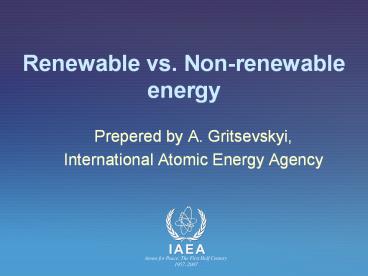Renewable vs. Non-renewable energy - PowerPoint PPT Presentation
Title:
Renewable vs. Non-renewable energy
Description:
Renewable vs. Non-renewable energy Prepered by A. Gritsevskyi, International Atomic Energy Agency Global energy balance and flows without anthropogenic interference. – PowerPoint PPT presentation
Number of Views:1839
Avg rating:3.0/5.0
Title: Renewable vs. Non-renewable energy
1
Renewable vs. Non-renewable energy
- Prepered by A. Gritsevskyi,
- International Atomic Energy Agency
2
Do we have any problem?
- In most cases
- there is no problem for energy statistics to
identify is that specific energy form belongs to
renewable or non-renewable not necessarily true
for other domain (geology, environment,
business)? - Problems start when we talk about energy
technology or dealing with some grey areas - Lack of clear definition and partial disagreement
on interpretation terms
3
What is in Series F Manuals? 29E, 44 and 56E
- No real definition
- Defined by listing
4
Fuel split in 29E
5
Extra note in 56E
- Fuelwood should be considered as renewable
only if rate of planting it faster or equal to
rate at which it is cut - Should something like that applied for large
scale of hydropower as currently there is
tendency not to name such technology as strictly
renewable?
6
Multiple ways to give a definition
- Postulating - listing what it is and what it is
not? - Giving criteria and checking if particular source
of energy meets it - Combination of both
7
Example 1
- Energy obtained from sources that are essentially
inexhaustible (unlike, for example the fossil
fuels, of which there is a finite supply).
Renewable sources of energy include wood, waste,
geothermal, wind, photovoltaic and solar thermal
energy - NOT OK as all energy sources we know within
defined system (Earth) are finite and fusion
power, technically non-renewable, could be
considered practically inexhaustible
8
Example 2
- energy generated from resources that are
unlimited, rapidly replenished or naturally
renewable such as wind, water, sun, wave and
refuse, and not from the combustion of fossil
fuels - Better, but rapidly is rather subjective term,
- so what about peat? (see attached paper)?
9
Example 3 and 4
- energy flows which occur naturally and repeatedly
in the environment, such as wind and solar - new and renewable energy sources are energy
sources including solar energy, geothermal
energy, wind power, hydropower, ocean energy
(thermal gradient, wave power and tidal power),
biomass, draught animal power, fuelwood, peat,
oil shale and tar sands, UN Glossary of
Environment Statistics F-67E
10
From Renewable Energy in Europe
- Renewable Energy Sources All natural energy
flows that are inexhaustible (i.e., renewable)
from an anthropogenic point of view solar
radiation hydropower wind geothermal wave,
and tidal energy and biomass
11
From Renewable Energy in the United States
- Renewable Energy Resources that are naturally
replenishing but flow limited. They are virtually
inexhaustible in duration but limited in the
amount of energy that is available per unit of
time.
12
Grey areas
- Municipal Waste or any waste from potentially
unsustainable use of biomass and/or unclear mixed
use of fossil fuel and renewable - Origin of the problem derived fuel with
potentially multiple sources - No clear solution provided in the available
literature treated differently from
case-to-case and region-by-region - Should be addressed jointly with environmental
statistics experts
13
Age of different types of fuelwithin parentheses
is maximum age
Source Hans Joosten Renewability revisited on
folly and swindle in peat energy politics
14
Energy flux(flow) and energy storefrom M.
Hoexter's What is Renewable Energy Anyway?
- Energy flux
- Energy store
15
- Non-renewable energy sources are energy stores
with zero or a minute rate of replenishment
relative to its depletion by human beings. Most
non-renewable energy sources are converted to
usable energy by thermal or nuclear reactions.
Non-renewable energy sources have stored the
natural energy flux of Earths biological and
geological past or of the formation of elements
in the early history of the Universe
16
- Renewable energy sources are types of natural
energy flux useful for human ends regularly
occurring on or near Earths surface and,
additionally, useful natural energy stores that
are replenished by natural flux within the time
frame of conceivable human use. All known
renewable energy sources originate in, or are
close derivatives of, electromagnetic radiation
of our Sun, the Earths and Moons gravitational
fields and heat radiating from earths interior.
Renewable energy sources are practically
inexhaustible though some sources such as
geothermal and ocean thermal energy conversion
may become locally depleted by human use at a
rate that exceeds replenishment by natural flux.
17
Global energy balance and flows without
anthropogenic interference
Source Energy Primer, Climate Change 1995.
Impacts, Adaptations and Mitigation of Climate
Change Scientific Analyses, IPCC
18
Three questions to the London Group
- Do you agree
- that the definition of renewable/non-renewable
should focus on renewability only and should be
independent of the purpose behind otherwise it
will be never accepted generally - that any fuel or energy form should be strictly
defined as renewable/non renewable without any
exception - that the timeframe of conceivable human use and
close derivatives of electromagnetic radiation of
our sun has to be defined exactly - and the final consequence
- Renewable technologies than are not necessarily
environmentally sound, sustainable or safe
19
Thank you for your attention
www.statistik.at































